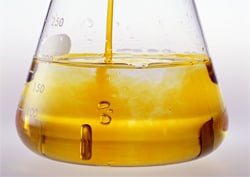Saponification
The xanthophyll group is the most complex carotenoid group in terms of number of compounds and variation in their structure. These compounds can be found in either their free form (like carotenes) or in a more stable fatty acid esterified form. The naturally complex availability of xanthophylls is increased by the formation of these carotenoid esters. That is why these compounds have been frequently analyzed after a saponification step.
The saponification is an extraction step aimed at removing chlorophylls and lipids to eventually release carotenoids in a clean preparation for analysis, free from conjugated forms, fatty acids and lipids that make the chromatography separation difficult. Saponification is also used for hydrolyzing carotenoid-esterified forms. Depending on the nature of the carotenoid and the food type, saponification may result in destruction or structural transformation. Recoveries of carotenoids depend on whether the saponification is performed or not, on the time used in the saponification procedure and the concentration of the alkaline treatments. In addition, considering the lack of carotenoid derivatives standards commercially available, their formation by saponification may result very useful for their analysis on food samples, and consequently for the study on their benefits in human health.







